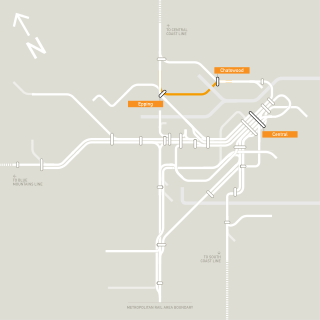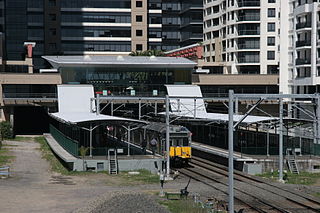Related Research Articles

The Epping to Chatswood rail link (ECRL) was a railway line in the northern suburbs of Sydney, Australia, which connected Epping station on the Northern line with Chatswood on the North Shore line.

Gladesville Bridge is an arch bridge near Gladesville that spans the Parramatta River, west of central Sydney, Australia. It links the suburbs of Huntleys Point and Drummoyne. It is a few kilometres upstream of the more famous Sydney Harbour Bridge and is part of Victoria Road. When it was completed in 1964, Gladesville Bridge was the longest single span concrete arch ever constructed. Gladesville Bridge is the largest of a complex of three bridges, including Fig Tree Bridge and Tarban Creek Bridge, designed to carry traffic as part of the North Western Expressway. The bridge was the first phase of this freeway project that was to connect traffic from the Newcastle via Wahroonga/Lane Cove, then through Glebe/Annandale to connect into the city. Due to community action the freeway project was abandoned by the Wran government in 1977, leaving the Gladesville bridge connecting the existing arterial roads.

The North Shore refers to a group of suburbs north of Sydney Central Business District in New South Wales, Australia. The term generally refers to the suburbs located on the northern side of Sydney Harbour up to and including Hornsby and between Middle Harbour and the Lane Cove River.

Lane Cove is a suburb on the Lower North Shore of Sydney, in the state of New South Wales, Australia. Lane Cove is nine kilometres north-west of the Sydney central business district and is the administrative centre for the local government area of the Lane Cove Council. It is serviced by schools, shops, cafes, restaurants, medical and dental services, recreational facilities and public transport. Lane Cove West and Lane Cove North are separate suburbs.

Hunters Hill is a suburb on the Lower North Shore and Northern Suburbs of Sydney, in the state of New South Wales, Australia. Hunters Hill is located 9 kilometres (5.6 mi) north-west of the Sydney central business district and is the administrative centre for the local government area of the Municipality of Hunter's Hill.

Wynyard railway station is a heritage-listed underground commuter rail station located in the north-west precinct of the Sydney central business district, in New South Wales, Australia. The station opened on 28 February 1932 to coincide with the opening of the Sydney Harbour Bridge.

St Leonards railway station is located on the North Shore line, serving the Sydney suburb of St Leonards including the nearby Artarmon Industrial Area and Gore Hill. It is served by Sydney Trains T1 North Shore line services.

Linley Point is a small peninsular suburb located on the Lower North Shore of Sydney, in the local government area of the Municipality of Lane Cove, in the state of New South Wales, Australia. It is approximately 10 kilometres north-west of the Sydney central business district by car.

The Sydney tramway network served the inner suburbs of Sydney, Australia from 1879 until 1961. In its heyday, it was the largest in Australia, the second largest in the Commonwealth of Nations, and one of the largest in the world. The network was heavily worked, with about 1,600 cars in service at any one time at its peak during the 1930s . Patronage peaked in 1945 at 405 million passenger journeys. Its maximum street trackage totalled 291 km in 1923.

Fig Tree Bridge is a concrete girder bridge that spans the Lane Cove River, 7 km northwest of the central business district of Sydney in New South Wales, Australia. It is immediately to the north of Tarban Creek Bridge. The bridge carries Burns Bay Road and a footpath and connects the suburbs of Hunters Hill and Linley Point.

Parramatta River ferry services connect suburbs along the Parramatta River in Sydney with Circular Quay by commuter ferry. The services are numbered F3 and form part of the Sydney Ferries network.

Sydney bus route 144 is operated by State Transit between Manly wharf and Chatswood station. It was Sydney's first government operated bus route.

The Northern Suburbs is the metropolitan area on the northern bank of the Parramatta River in Sydney, New South Wales, Australia beginning with suburbs in line with or east of West Pennant Hills and ending with suburbs west of the Lane Cove National Park, south of Hornsby. This area includes suburbs in the local government areas of Hornsby Shire, City of Ryde, the Municipality of Hunter's Hill, and parts of the City of Parramatta.

Victoria Road is a major road in Sydney, New South Wales, Australia.

Metrobus is an Australian high frequency, high capacity bus network in Sydney that links key employment and growth centres. Metrobuses run every 10 minutes during peak periods, 15 minutes during off-peak weekday periods, and 20 minutes on weekends, with the intention of making timetables obsolete. All buses were initially painted in a distinctive red livery but now often buses in other liveries are used. All Metrobuses are wheelchair accessible. All route numbers were prefixed with an "M" followed by 2 numbers.
Deanes Coaches was an Australian bus company operating route bus services and charter coaches on Sydney's North Shore.

North & Western Bus Lines was an Australian bus company operating route bus services and charter coaches in Sydney.
Captain Cook Cruises is an Australian cruise operator. As of January 2018, the company operated 21 vessels on Sydney Harbour, providing a range of Government contracted and non-contracted Ferry services, Sightseeing, Dining and Charter Cruises.
White Transit Company was an Australian bus company operating route bus services on Sydney's Lower North Shore.
North Sydney Bus Charters is an Australian bus company operating charter services in Sydney.